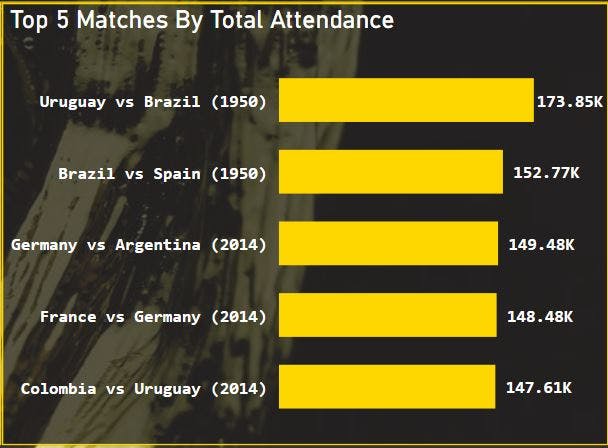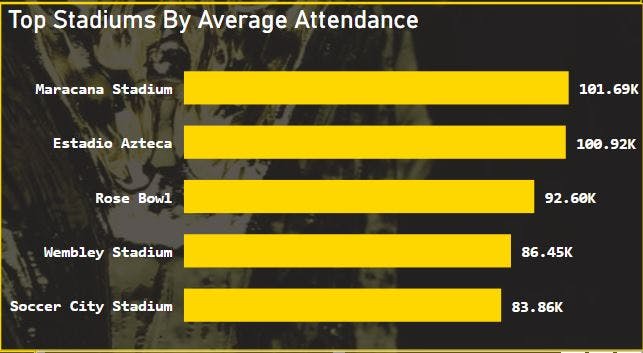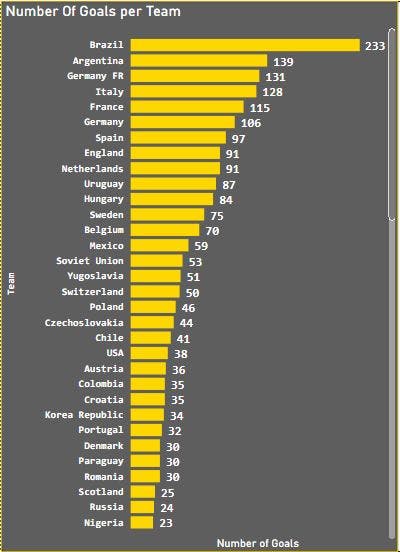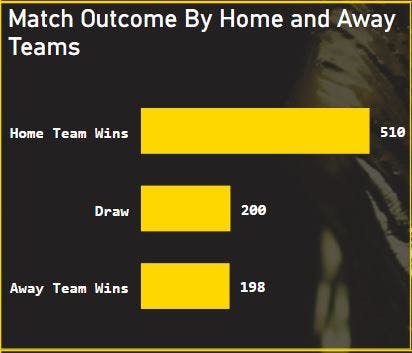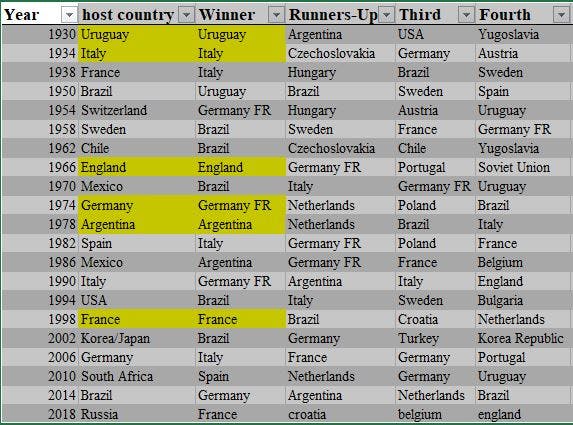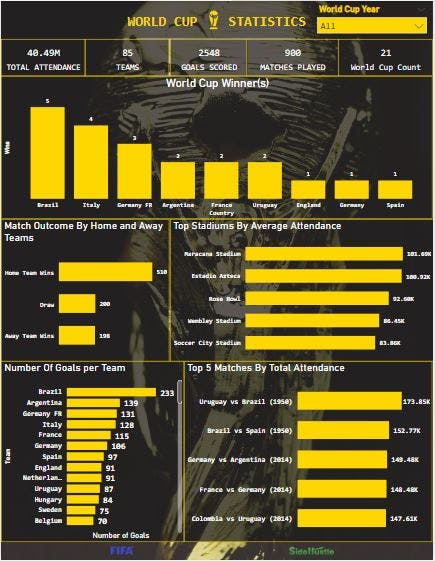Table of contents
Introduction
It's been 3 weeks of the side-hustle 5.0 bootcamp, inserts Bon Jovi's livin' on a prayer* cause ohh, we are halfway there! Working as a team has been challenging but in all the experience has been exciting, lessons have been learnt, bonds formed and connections made, it's been quite a journey. For this week our task was to analyse data from every world cup that has been held, specifically answering the following questions:
- Number of world cup winning titles
- Total attendance, number of teams, goals scored and matches per cup
- Goals per team per world cup
- Matches with the highest number of attendance
- Stadium with the highest average attendance
- Countries that have won the world cup
- Number of goals per team
- Match outcome by home and away teams
With this, the team set out to do the needful, finding data...
Data Sources
These datasets were merged using excel spreadsheet and sub-tables were created, a lot of exciting stuff but we'll get to that ;D
Analysing The Data
To answer the analysis questions given in the task, "sub-tables" were created from our dataset and kept in separate excel worksheets. The sub-tables were created using pivot tables, index and match functions and other excel features. The tables created include
World Cup Years - containing years in which the world cup was held.
World Cup Summary - containing summary information of each world cup held, the winners, first runner up, total goals scored etc.
World Cup Teams - containing information on each team's performance in every world cup
After these worksheets were created, the tables were loaded into PowerBI where it was cleaned using power query and modelled using PowerBI.
Answers To Task Questions
The number of titles won at the World Cup and the year:
According to the data, Brazil has won the most championships (5 times) which is the highest number of wins for any country, followed by Italy (4 times), Germany FR (3 times), Argentina, Uruguay, and France (2 times each), Spain, England, and Germany (1 time each). Countries and the year they won include Uruguay; in 1930, 1934, 1938, 1982, and 2006, Italy; In 1958, 1962, 1970, 1994, and 2002, Brazil took home the trophy. In 2010 Spain won, followed by Germany in 2014, and France in 2018.
Total Attendance, Number of Teams, Goals Scored and Matches:
The total attendance from 1930 to 2018 was 40,489,415 with the highest attendance in 1994 (3,587,538), followed by 2014(3,386,810) and 2006(3,359,439) while the least attendance occurred in 1934(363,000), 1938(375,700) and 1930(5,90,549). The number of teams participating in the world cup increased from 13 teams in 1930 to 32 teams in 2018 showing an increase in the popularity of the sport and inclusivity.
The most goal scored was in 1988 with 171 total goals scored with the least being in the 1930 and 1934 world cup with 70 goals in total each.
An increase in the teams participating in the world cups resulted in an increase in the total match played in each world cup, increasing from 18 matches in 1930 to 64 matches in 2018.
World Cup Goals Per Team:
The most goals scored by any team in the world cup history was by Germany in the year 2014, scoring 29 goals out of the 171 goals scored that year.
Match with the Most Attendance:
The Uruguay vs Brazil match played at the group stage in the 1950 world cup in Estadio de Maracana, Rio de Janeiro had a total attendance of 173,850 which was the most attended of all time.
Stadium with Highest Average Attendance:
The Estadio Azteca in Mexico City has the highest average attendance with 100, 923 average attendance, the Rose Bowl with 92,600 average attendance, Wembley Stadium with 86,448 average attendance, Estadio de Maracana with 86,417 average attendance and Soccer City Stadium with 83,857 average attendance have the second, third, fourth and fifth highest average attendance.
Goals Scored Per Team
Brazil, Argentina, Germany FR, Italy, and France have scored the most goals in world cup history with 233, 139, 131, 128, and 115 goals respectively, with Canada, China PR, Dutch East Indies, Republic of Ireland, Trinidad and Tobago, United Arab Emirates and Zaire to have scored 0 goals.
Match Outcome By Home and Away Team
Teams in the home category are seen to have won most of the matches than teams in the away category
Out of the 21 world cup tournament held, 6 have been won by the host country; Uruguay in 1930, Italy in 1934, England in 1966, Germany FR in 1974, Argentina in 1978, and France in 1998.
To conclude our report on the FIFA World Cup, here are a few tips for countries like Canada, China PR, Dutch East Indies, Republic of Ireland, Trinidad and Tobago, United Arab Emirates and Zaire (Yes this is a direct sub)
Use rondos to perfect passing: There is no greater skill in any version of FIFA than holding onto the damn ball. The rondo might seem like a pointless exercise to simply get the team a tick on a training drill but the more teammates pass, the better they get at the game in general. It's no surprise that Alex Hunter was made to do this in the dressing room in The Journey - Barcelona themselves used to do rondos while getting changed when Pep Guardiola was there.
Trigger runs: It’s important to learn who to trigger and who not to, though. Triggering a run from your full-back or winger can help to stretch the play - getting your centre-back to run into space ahead of him will leave you a man short if you lose the ball.
Create your set routines or automatisms: Passing and making runs is what will get the ball further up the pitch, right? Well, this is where automatisms come in when you’re playing out of the defence. Antonio Conte is a master of “automatism”. This is simply a set pattern of play - usually in the defence - which is rehearsed to perfection. It’s good to have a few of these in FIFA. For example, if the goalkeeper plays a ball out to a full-back, he might want to pass it to the CDM( Central Defensive Midfielder )and run on; with the opposition marker now turned to the CDM to press, the CDM can play the ball back in a one-two to the full-back. It doesn’t matter how often you do this - your opposition will usually fall for it. It just creates space and helps to progress your team forward.
Click Here for a link to Excel and PowerBI files used in the analysis.


